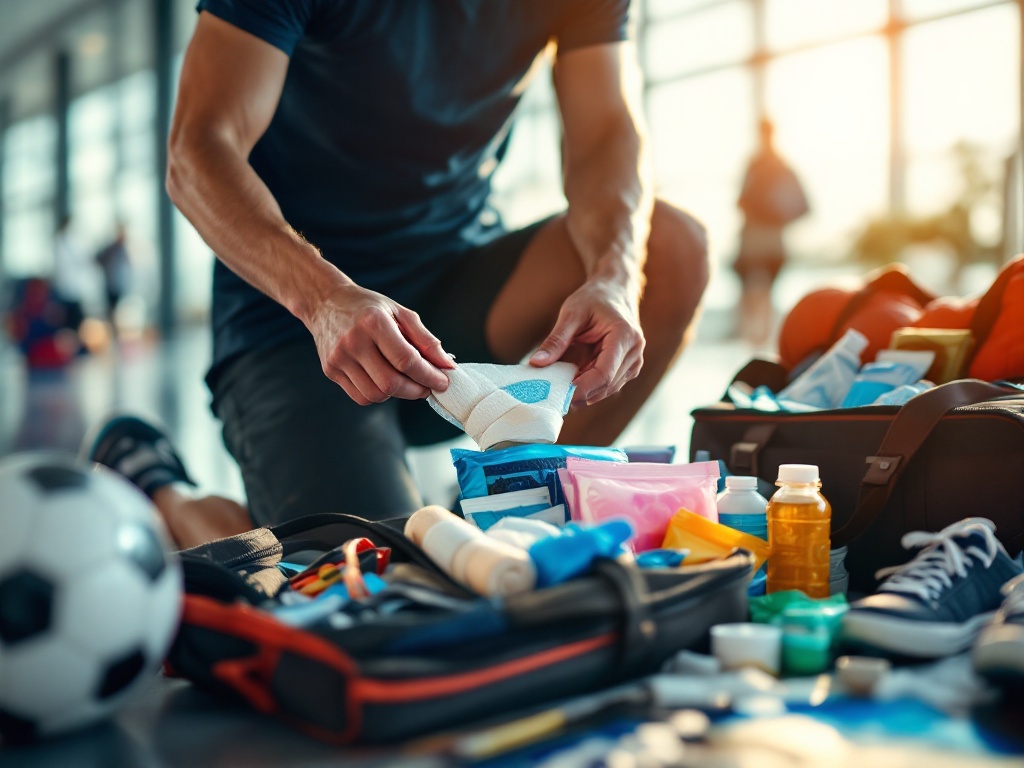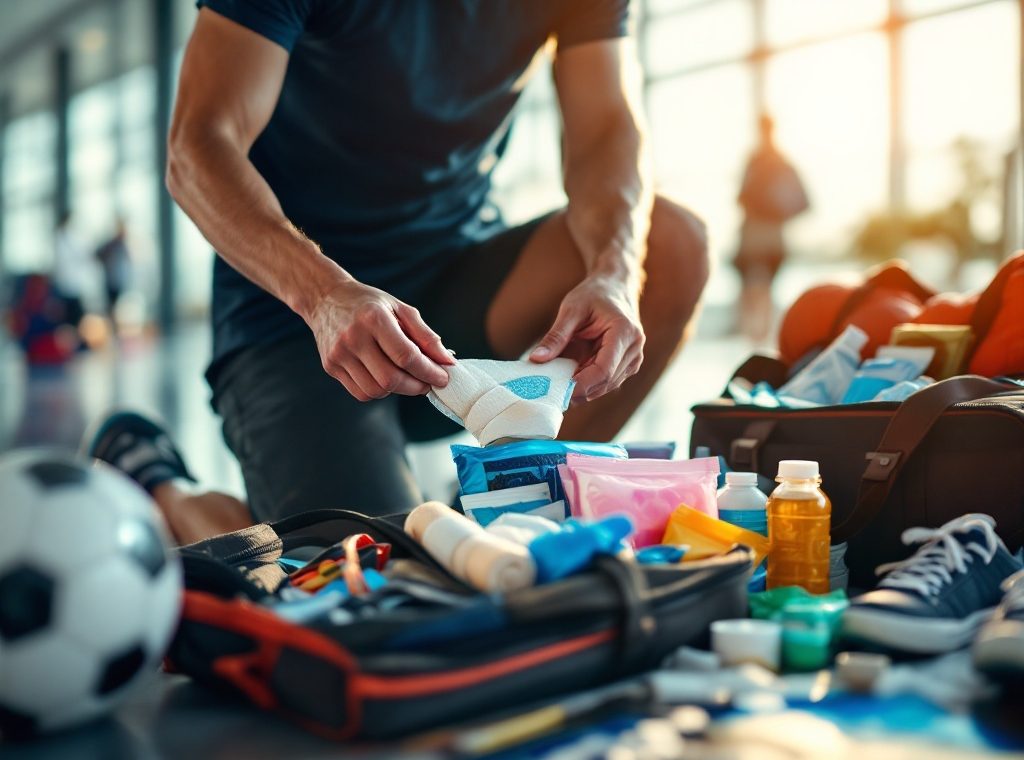Managing Injuries While Traveling for Sports
Did you know sports injuries rose by 12% in 2022, especially during travel? Protect yourself with proactive strategies. Learn how to prevent and manage injuries with the RICE method (Rest, Ice, Compression, Elevation), pack a well-stocked first-aid kit, and find local healthcare resources. Discover essential travel tips for athletes, from maintaining hydration and safe eating practices to carrying your home exercise program. Ensure a safe and healthy trip – read more now!
Important information

- Warm up, hydrate, and stretch lightly to prevent injuries.
- Use the RICE method (Rest, Ice, Compression, Elevation) for minor injuries.
- Pack a first-aid kit with essentials like bandages, antiseptic wipes, pain relievers, and any personal medications.
- Secure travel insurance that covers sports-related medical emergencies and research local healthcare options.
- Maintain healthy habits while traveling by prioritizing hydration, choosing safe food options, and monitoring your well-being.
Understanding Sports Care and Injury Prevention
Traveling for sports presents unique health risks. Athletes are particularly vulnerable to illness and injury while on the road, with sports injuries increasing by 12% in 2022. Fortunately, you can take proactive steps to safeguard your well-being.
Injury Prevention Strategies
- Prioritize warming up, hydration, and light stretching.
- Ensure proper footwear and avoid overexertion.
- For minor injuries, use the RICE method (Rest, Ice, Compression, Elevation).
- Seek immediate medical attention for serious injuries.
Essential Travel Preparations
- Secure travel insurance that covers medical emergencies.
- Pack a well-stocked first aid kit.
Regular strength training and flexibility exercises, along with gradual acclimatization to new environments, can significantly reduce your risk of injury and illness.
How to Manage Sports-Related Injuries During Travel
Rest the injured area to prevent further damage.
Apply ice to the injured area for 15-20 minutes at a time, several times a day. This helps reduce swelling and pain.
Use compression, such as a bandage, to help reduce swelling.
Elevate the injured area above your heart to minimize swelling.
Seek immediate medical attention for serious injuries.
Monitor your symptoms and, if possible, do gentle exercises to maintain your range of motion. Prioritize comfort and safety while traveling. This might include using support devices or taking breaks on long trips.
Researching Local Healthcare Options Before Travel
Planning for potential medical needs is crucial for any trip, especially one involving physical activity. Confirm your travel insurance covers sports-related injuries. Before you leave, research local healthcare options, including doctors, clinics, and hospitals. Keep your personal physician’s contact information accessible. Connecting with local sports networks can also be a valuable resource. Prioritize injury prevention through pre-travel conditioning, proper hydration, and good nutrition for a healthier and more enjoyable trip.
Before Your Trip
- Verify your travel insurance covers sports injuries.
- Research and compile a list of nearby doctors, clinics, and hospitals.
- Ensure you have easy access to your physician’s contact information.
- Consider connecting with local sports networks for additional support.
For Injury Prevention
- Prioritize pre-travel conditioning to prepare your body for activities.
- Maintain proper hydration before, during, and after any physical activity.
- Focus on good nutrition to support your body’s performance and recovery.
Packing Essentials for Injury Management
Pack the following essential items in your first aid kit:
- Adhesive bandages for minor cuts and scrapes.
- Antiseptic wipes for cleaning wounds.
- Antibiotic ointment to prevent infection.
- Ice packs or instant cold compresses for new injuries.
- Elastic bandages for support and compression of sprains and strains.
- Pain relievers (ibuprofen or acetaminophen) to manage discomfort.
Consider these additional items for a comprehensive kit:
- Kinesiology tape for added support.
- A foam roller to aid muscle recovery.
- Your prescribed medications and a list of emergency contacts.
- Blister treatment and small scissors.
Creating a Makeshift Ice Pack: Fill a zip-lock bag with ice and water.
Seal the bag tightly and remove excess air.
Wrap the bag in a thin towel.
Apply to the injury for 15-20 minutes at a time.
Bring a copy of your home exercise program to maintain your rehabilitation plan while traveling. This ensures consistency and helps prevent setbacks, allowing you to continue your exercises even without your usual therapist or equipment.
What to Include in a Comprehensive First Aid Kit
A well-stocked first aid kit is essential for handling unexpected injuries. Equip yours with adhesive bandages for minor cuts, antiseptic wipes for cleaning wounds, and ice packs to reduce swelling. Elastic bandages offer support, while pain relievers help manage discomfort. For muscle injuries, include kinesiology tape and a foam roller to promote recovery. Don’t forget essential personal items like prescribed medications and emergency contact information, crucial in any crisis. Here’s a helpful list to ensure your kit is comprehensive:
- Adhesive bandages: for covering minor cuts and scrapes.
- Antiseptic wipes: to clean wounds and prevent infection.
- Ice packs: for reducing swelling and pain.
- Elastic bandages: to provide support and compression.
- Pain relievers: for managing pain and discomfort.
- Kinesiology tape: to support muscles and joints.
- Foam roller: to massage muscles and aid recovery.
- Prescribed medications: ensure you have an adequate supply.
- Emergency contact information: crucial in case of a crisis.
How to Use Zip Lock Bags for Ice Therapy
Soothe your aching shoulder with a simple ice pack. For optimal relief, fill a large, 3-gallon zip-lock bag with ice. Its size conforms comfortably to the body, providing effective cold therapy.
Why Carry a Copy of Your Home Exercise Program
Maintaining your home exercise program while traveling, especially when recovering from an injury, is crucial for preserving strength and flexibility. Consistency promotes faster healing and prevents setbacks, ensuring your progress continues uninterrupted. Here’s how to stay on track:
Pack resistance bands. these versatile tools are lightweight, portable, and offer a wide range of exercise possibilities, mimicking many gym exercises.
Utilize bodyweight exercises. Bodyweight exercises such as squats, lunges, push-ups, and planks can be performed anywhere, requiring no equipment.
Explore hotel fitness centers. Many hotels offer basic fitness facilities, allowing you to maintain your cardio routine and access some weights. If unavailable consider nearby gyms that offer day passes.
Incorporate active recovery. Swimming, walking, or gentle yoga can maintain mobility and promote blood flow, aiding in the healing process.
Prioritize consistency over intensity. Even shorter, less intense workouts are beneficial when traveling. Focus on maintaining the habit and listen to your body, modifying or shortening exercises as needed.
Traveling with an Injury: Tips for Comfort and Safety
Traveling with an injury requires careful planning to ensure a safe and comfortable trip. Consider these helpful tips:
Use an airplane pillow. An airplane pillow can provide crucial support and ease discomfort on long flights.
Get luggage assistance. Request assistance with your luggage to prevent exacerbating your injury.
Lift carefully. When lifting, rely on your uninjured arm to protect the affected area.
These precautions will make your trip safer and significantly more comfortable.
How to Use Airplane Pillows for Support
Airplane pillows are travel essentials, providing crucial support for your neck, back, and legs. They promote good posture and reduce pressure, ensuring a more comfortable journey. Placing a pillow behind your lower back helps maintain the natural curve of your spine.
Side sleepers can benefit by placing a pillow between their knees for optimal hip and spine alignment. Supporting your neck with a pillow can also prevent stiffness and discomfort.
Why You Should Get Help with Luggage
Lifting heavy luggage can strain your body and worsen any prior injuries. To avoid this, ask for help with your bags. This simple step can make your trip much more enjoyable and comfortable.
Preventing Strain by Using Your Good Arm
Protect your injured arm by using your stronger arm for strenuous activities, such as pulling luggage. To minimize strain and facilitate healing, consider renting a cart at the airport or train station. This precaution helps ensure a quicker recovery.
Maintaining Health and Performance During Travel
Staying in top form while traveling is essential for athletes. Hydration plays a vital role, regulating body temperature and aiding in nutrient absorption and waste elimination. Choose bottled water, particularly in areas with uncertain water quality. To prevent foodborne illnesses that can hinder performance, select thoroughly cooked meals and avoid raw or undercooked meat, seafood, and eggs. Whenever possible, opt for reputable establishments or prepare your own meals. Choose fruits and vegetables that can be peeled or washed thoroughly. While tempting, approach street food with caution. If you do indulge, select vendors with high turnover and visible cleanliness. Monitor your health and seek medical attention if you experience any signs of illness. Packing a basic first-aid kit containing essentials like anti-diarrheal medication and oral rehydration salts is always advisable.
Prioritize hydration. Drink bottled water, especially where water quality is uncertain, to regulate body temperature and support nutrient absorption.
Choose food carefully. Opt for thoroughly cooked meals and avoid raw or undercooked meat, seafood, and eggs to prevent foodborne illnesses.
Select reputable dining. Whenever possible, dine at established restaurants or prepare your own food.
Handle produce properly. Choose fruits and vegetables that can be peeled or washed thoroughly.
Approach street food with caution. If indulging, select vendors with high turnover and visible cleanliness.
Monitor your well-being. Seek medical care if you experience any signs of illness.
Pack a first-aid kit. Include essentials like anti-diarrheal medication and oral rehydration salts.
Effective Hydration and Safe Eating Practices
Staying hydrated is crucial, especially when traveling. Pack bottled water or select other safe beverages, and exercise caution with tap water in certain areas. Food safety is equally vital. Choose well-cooked meals and enjoy easy-to-peel fruits. Avoid raw or undercooked meats, seafood, and eggs – for example, a medium-rare burger could pose a risk. These precautions minimize the chance of foodborne illness and contribute to a healthier, more enjoyable trip.
Monitoring and Managing Symptoms Early
Address any new or worsening symptoms promptly. See a doctor if they persist or intensify, as early intervention can prevent minor issues from escalating into major problems. Swift action is crucial.


















